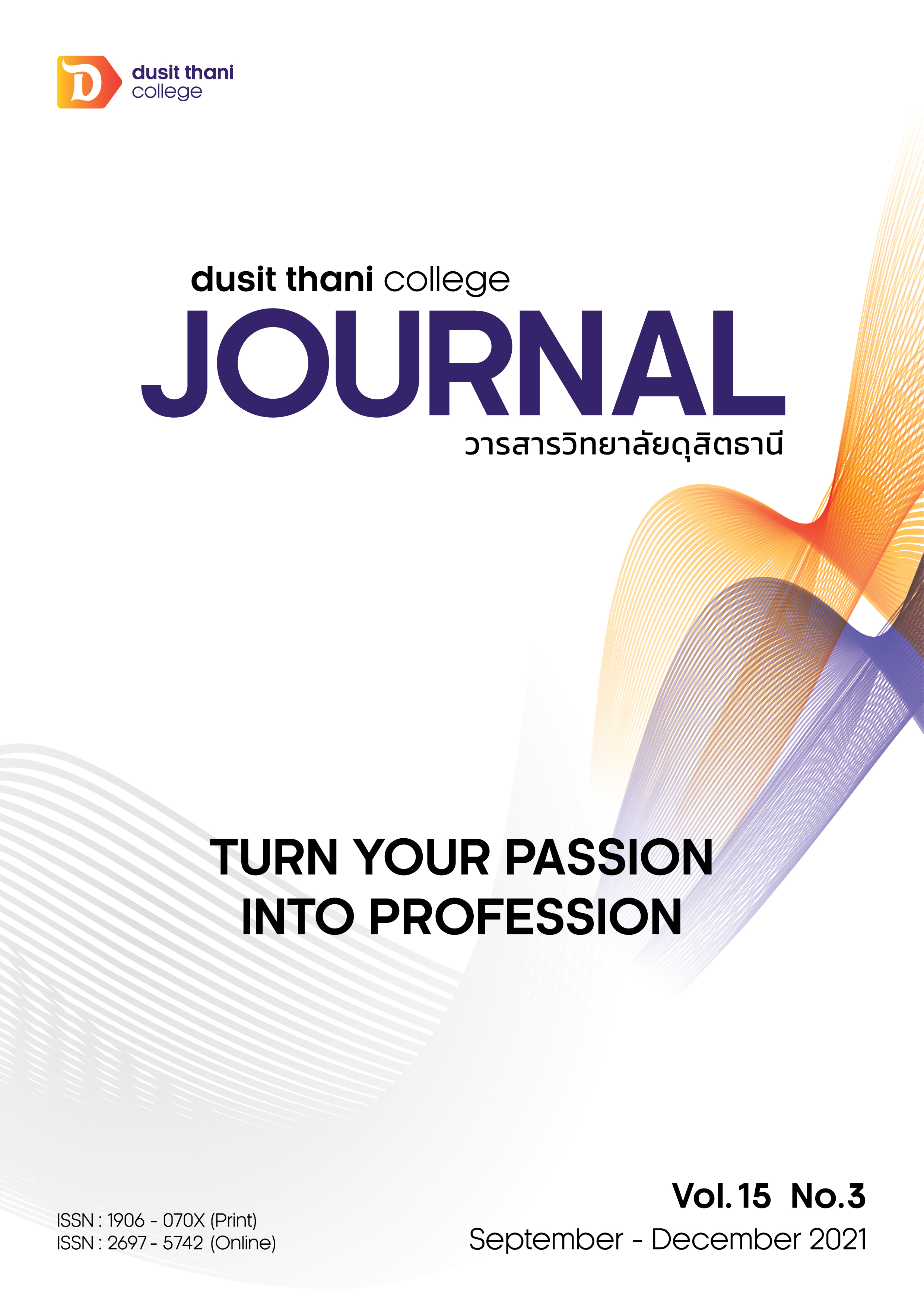DRAGON FRUIT PEELS LEATHER MIXED PLUM POWDER PRODUCTS
Main Article Content
บทคัดย่อ
This research aims to study the amount of plum powder suitable for the quality of dragon fruit peels leather mixed plum powder products, to study the nutritional value of dragon fruit peels leather mixed plum powder products and study consumer acceptance. By studying the amount of plum powder with 4 different levels: 0 percent (control formula), 1, 2, and 3 percent by weight of all ingredient, and then studying consumer acceptance. Study physical and chemical properties including color values (L* a* and b*), toughness Stickiness, Water Activity (Aw) and pH study nutritional values include moisture, ash, protein, fat, fiber, carbohydrates and calories. The results showed that the amount of plum powder used in the dragon fruit peels leather mixed plum powder products. Affects consumer acceptance, effects on physical and chemical properties and nutritional value of dragon fruit peels leather mixed plum powder products. When there is a larger amount of plum powder, the color values (L* and b*), toughness and stickiness are reduced, while the color values (a*) and pH are statistically significantly increased (p <0.05) and have a nutritional value of moisture, ash, protein, fat, fiber, carbohydrates and calories to 29.22, 11.76, 3.07, 0.14, 3.79 and 81.22 grams per 100 grams and calories 338.42 kcal. The moisture content, ash, protein, fat and fiber of dragon fruit peels leather mixed plum powder products increased statistically significantly. However the total amount of carbohydrates and calories decreased, according to the study, and consumers accepted the dragon fruit peels leather mixed plum powder products with the highest amount of plum powder at 3 percent. There is a moderate to very like acceptance score in all features.
Article Details
นโยบายการพิจารณากลั่นกรองบทความ
- บทความวิจัยและบทความวิชาการทุกเรื่องที่จะได้รับการตีพิมพ์ต้องผ่านการพิจารณากลั่นกรองโดยผู้ทรงคุณวุฒิ (Peer Review) ในสาขาที่เกี่ยวข้อง จำนวน 3 ท่าน/บทความ
- บทความ ข้อความ ภาพประกอบและตารางประกอบที่ลงตีพิมพ์ในวารสารเป็นความคิดเห็นส่วนตัวของผู้เขียน กองบรรณาธิการไม่จำเป็นต้องเห็นด้วยเสมอไป และไม่มีส่วนรับผิดชอบใด ๆ ถือเป็นความรับผิดชอบของผู้เขียนแต่เพียงผู้เดียว
- บทความที่จะได้รับการตีพิมพ์จะต้องไม่เคยตีพิมพ์ เผยแพร่ที่ใดมาก่อน และไม่อยู่ระหว่างการพิจารณาของวารสารฉบับอื่น หากตรวจสอบพบว่ามีการตีพิมพ์ซ้ำซ้อน ถือเป็นความรับผิดชอบของผู้เขียนแต่เพียงผู้เดียว
- บทความใดที่ผู้อ่านเห็นว่าได้มีการลอกเลียนหรือแอบอ้างโดยปราศจากการอ้างอิง หรือทำให้เข้าใจผิดว่าเป็นผลงานของผู้เขียน กรุณาแจ้งให้กองบรรณาธิการวารสารทราบจะเป็นพระคุณยิ่ง
เอกสารอ้างอิง
AOAC. (2000). Official Method of Analysis, Association of Official Analytical Chemists, Virginia.
Boonmee, K. (2019). Used of Dragon Fruit (Hylocereusundatus) Shell Substitute Pork Skin and Nitrate in Nham. National Academic Conference Rangsit University Year 2019. (Online). Available from: https://rsucon.rsu.ac.th/files/proceedings/nation2019/NA19-033.pdf. 20 December 2020. (in Thai)
Dangkrajang, S., Sirichote, A. and Suwansichon, T. (2009). Development of roselle leather from roselle (Hibiscus sabdariffa L.) by-product. Asian Journal of Food and Agro-Industry.2(04): 788-795.
Dayang Norulfairuz Abang Zaidel, Jamaeyah Md Rashida, Nurul Hazirah Hamidona, Liza Md. Salleha, and Angzzas Sari Mohd Kassim. (2017). Extraction and Characterisation of Pectin from Dragon Fruit (Hylocereus Polyrhizus) Peels. Chemical Engineering Transactions. Vol. 56: 805-810.
Department of Agricultural Extension. (2017). Agricultural Production Information System : Dragon Fruit. (Online). Available from: ้ttp://www.agriinfo.doae.go.th/year60/plant/rortor/fruit1/dragonfruit.pdf. 20 January 2018. (in Thai)
Diawkee, T. (2018). Washing vegetables. (Online). Available from: https://www.thaihealth.or.th /Content/43286%E0%B8%81%E0%B8%B2%E0%B8%A3%E0%B8%A5%E0%B9%89%E0%B8%B2%E0%B8%87%E0%B8%9C%E0%B8%B1%E0%B8%81%20.html . 20 January 2018. (in Thai)
Jangchud, A., Tungsawas, P., Taratornkul, A., Luangwilai, S. and Jangchud, K. (2006).
Development of apricot leather from salted apricot. Proceedings of 44th Kasetsart University Annual Conference : Agro-Industry, Economics and Business Administration.pp. 514-524. (in Thai)
Lourith, N. and Kanlayavattanakul, M. (2013). Antioxidant and stability of dragon fruit peel colour. Agro FOOD Industry Hi Tech. 24(3): 56-58.
Masomrong, K. and Suntornsuk, W. (2014). Antioxidant and Antibacterial Activities of Natural Extract from Dragon Fruit Peel. Agri Sci. J. 45(2) (Suppl.): 269-272 (in Thai)
Nur Izalin, M. Z., Kharidah, M., Jamilah, B., Noranizan, M. A. (2016). Functional properties of pectin from dragon fruit (Hylocereus polyrhizus) peel and its sensory attributes. J.Trop. Agric. and Fd. Sc. 44(1): 95 – 101.
O-Chongpian, P., Pimpa, P. and antrawut, P. (2017). Development of Eyes Mask Containing Dragon Fruit Peel Extract. Journal of Agriculture. 33(3): 415 – 425. (in Thai)
Office of Industrial Product Standards. (2015). THAI COMMUNITY PRODUCT STANDARD (136/2015) DRIED FRUITS AND VEGETABLES. (Online). Available from:
http://tcps.tisi.go.th/pub/tcps0136_58 (ผลไม้แห้ง).pdf. 22 November 2020. (in Thai)
Papagiannopoulos, A., Sotiropoulos, K., and Radulescu, A. (2016). Scattering investigation of multiscale organization in aqueous solutions of native xanthan. Carbohydrate polymers. 153, 196-202.
Sakkaekaew, K., Pasukamonset, P. and Siriwong, N. (2020). Effects of Fat Replacement by Pectin from Dragon Fruit Peels on Physicochemical Properties of Salad Dressing. Dusit Thani College Journal. 14(3): 328-342. (in Thai)
Stk-th. (2019). Is Eating Fruit Difficult for You?. (Online). Available from: http://www.stk-th.com. 24 January 2019. (in Thai)


